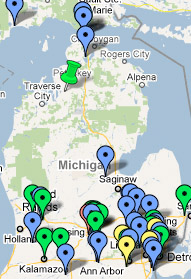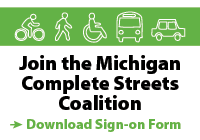Reposted from LMB.org
FederalFederal Transit Administration (FTA) has issued a policy statement in today’s Federal Register establishing that pedestrian improvements within a half mile radius of a transit facility and bicycle improvements within a 3-mile radius of the transit facility are considered to have a de facto relationship to the transit facility. This is great news as it simplifies the eligibility determinations for use of transit funds for bicycle and pedestrian improvements.
The majority of FTA’s grant programs allow money to be spent on the design, construction, and maintenance of walking and biking projects that “enhance or are related to public transportation facilities.” But how do they determine if such a relationship exists? Until today’s announcement, the FTA had used 1,500 feet from the transit stop or station as the rule of thumb.
Additionally, in response to public comments, the FTA also included a stipulation that allows projects located beyond these distances to be eligible if walkers and cyclists could reasonable be expected to make longer trips.
LMB is extremely pleased that this new policy recognizes that successful transit depends on safe and convenient access to transit stops, especially within nearby walk and bike catch basins. Making bicycling and walking safe and attractive makes transit more accessible, practical and appealing. In addition, providing secure bike parking is far cheaper than building surface or structure automobile parking.
You can read the entire policy statement here and read more on the history of this significant policy change on the League of American Bicyclists’ blog. Below are a few excerpts specifically related to bicycling and complete streets.
“Distances beyond the ‘‘walkshed” of public transportation stops and stations may, in fact, be within the range of a short bicycle trip. Indeed, as one author stated, ‘‘[bicycles] are the perfect transportation choice for a short one- to three-mile trip to and from a transit station.” Providing secure parking and other amenities for bicycles and cyclists at public transportation stops or stations can be less expensive than providing parking for automobiles. Access to public transportation allows bicyclists the opportunity to make longer trips. Further, where physical conditions prevent a continuous bicycle trip, public transportation can provide a link to previously inaccessible destinations.”
“In addition, investing in a ‘complete street’ concept stimulates private-sector economic activity by increasing the viability of street-level retail small businesses and professional services, creating housing opportunities and extending the usefulness of school and transit facilities.” As one leading scholar noted, ‘‘Pedestrian and bicycle traffic use fewer resources and affect the environment less than any other form of transport.” If we are to create livable communities, ‘‘the range of transportation choices available to all Americans-including transit, walking, bicycling, and improved connectivity for various modes-must be expanded.”
















2 comments
Comments feed for this article
August 19, 2011 at 5:52 pm
League of Michigan Bicyclists
More on this on the League of American Bicyclists’ blog: http://networkedblogs.com/lT41K
November 24, 2012 at 6:36 am
Spokespeople » Spokespeople Rides June 2 to Fish Ladders & the Ship Canal Trail
[…] safe and comfortable routes being constructed to support people who choose or need to walk or bike? Federal Transit Administration guidelines encourage safe and pleasant ways to access stations on foot or by […]